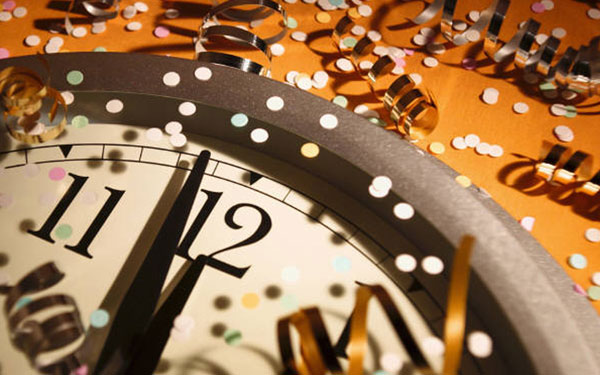 by Kimberly Blackford
by Kimberly Blackford

Celebrating the New Year evokes memories of partying with friends, great food, champagne flutes and midnight kisses. It is celebrated in almost every country with a wide variety of festivals and traditions. People have been enjoying celebrations in honor of the New Year for hundreds of years. These festivals mark a time to make a fresh start for the coming year and reflect on the past year. Many unique traditions have developed in different cultures to celebrate this joyous time.
The most common and well-known tradition is the New Year resolution. A classic resolution in past times was to make certain to clear all their borrowings from the past year. That way the person would start with a “clean slate” for the upcoming year. In more recent years, the New Year resolutions have developed into other efforts to start the year brand new. Many refer to it as “turning over a new leaf,” and spend the first day of the New Year reflecting on the past year and resolving to improve for the next. Some popular resolutions are losing weight, quitting smoking and becoming financially stable. Whatever the resolution may be, try to stick to it and feel good that you got something accomplished.

Almost every New Year’s celebration involves creating a lot of noise and merriment when the clock hits midnight. The idea of making deafening noise originated from the belief that it will drive away evil spirits who flock to the living at this climactic event. Great wailing of horns, shouts, whistles, bells and drums can be heard widespread on New Year’s Eve. Many celebrations enjoy fireworks and noisemakers to scare away evil spirits. Nonetheless, festive music and joyous singing bring together masses of people to bring in the New Year.
Auld Lang Syne is the most commonly sung song on New Year’s Eve, even if no one can recognize the actual words. Originating as a 1796 Scottish poem, famous bandleader, Guy Lombardo, played it at midnight at a New Year’s Eve party in New York City in 1929 and many years thereafter. “Auld Lang Syne” translates to “old long since” but is known to mean “times gone by.” The lyrics arise the question if “old friends and times will be forgotten,” promising to remember the past with fondness. Most American New Year’s Eve celebrations would be incomplete without hearing and singing this iconic song.

When that clock strikes midnight, it is customary to kiss someone whom you hold dear to you. It is believed that failure to observe this practice means the next year may be full of cold feelings. Originating with the Roman Festival of Saturnalia, the New Year’s Eve kiss is a symbol that your affection and closeness will last all year. Dating back to this ancient Roman celebration, everyone would try to kiss each other as much as possible on New Year’s Eve. The Europeans continue this tradition with the introduction of masked balls. The masks symbolized evil spirits from the past year. At midnight, everyone would remove their masks and kiss to symbolize the purification into the New Year. This will ensure that romance will favor your relations for next twelve months.

One ancient tradition of signifying the New Year involves the commemoration of a baby. Originating in Greece around 600 BC, the people would celebrate Dionysus, the god of wine, by parading a baby in a basket. This represented the annual rebirth of that god as the spirit of fertility. The Church finally allowed its members to celebrate this New Year baby tradition by promoting the birth of the baby Jesus. Many towns would watch for the first new baby of the year and shower him or her with gifts and attention. Although Greek and early Christian mothers seemed to disapprove of parading a living baby through the streets, its popularity overcame the objections. Hundreds of years later, German ancestors continued aspects of this tradition and brought it to America. This symbol remains a popular tradition today, usually being a diapered boy with a sash labeled with the number of the upcoming year.
 Another way that many people celebrate the New Year is by consuming black-eyed peas.
Another way that many people celebrate the New Year is by consuming black-eyed peas.
These peas and other legumes are considered to bring good luck and prosperity in many cultures. The practice of eating black-eyed peas for luck is believed to date back to the Civil War. The peas were first grown as food for livestock and Southern slaves. The black-eyed pea fields survived Sherman’s troops who destroyed and stole other crops, thus giving them an important role as a major food source since it survived the Confederates.
Other popular foods for the New Year that perfectly accompany black-eyed peas are ham, pork, cabbage, cornbread and collard greens. The hog is considered lucky and symbolizes prosperity. Additionally, since pork is often paired with sauerkraut because it tastes delicious together, the cabbage/hog combination ensures financial success. Cabbage leaves, collard, mustard and turnip greens symbolize paper money, whereas the peas signify coins and cornbread represents gold. Black-eyed peas eaten with stewed tomatoes constitute wealth and health. Some practice this tradition by adding a shiny penny or dime in the pot of stew just before serving. The person who receives the lucky coin will receive the most prosperity for the New Year.
An ancient European custom of the New Year is called “first-footing.” The first person to visit your home on New Year’s Day has significance for the luck of the next year. For the best luck, a male with dark hair should be the first to enter a home after midnight on New Year’s Day. He should carry a gift, such as a coin for prosperity, bread for food, salt for flavor or whiskey for good cheer. For the best luck, be sure that your dark haired man does not have flat feet, crossed-eyes or a unibrow. Blondes should be avoided as first-footers because they were associated with Vikings, who were visitors that never brought good luck. The first-footer can be a resident of the house, but must not be present during the hour leading up to midnight.
Another custom is to refrain from removing anything from the home on New Year’s Day. Some people will allow items to leave only after something has been brought into the home. This supports the idea that something should be added to your house before anything is taken away. Be sure to pack up your car with the items you will need for that day and take out the trash before midnight. Others will hold off on washing dishes and even their hair on New Year’s Day. This is often thought to wash away luck and is rumored to cause a death in the family in the next year.
Since earliest times, people have satisfied the deep-rooted longing to celebrate the New Year. Evolving from many ancient traditions all over the world, New Year festivals mark a crucial point where time is deemed to begin fresh and anew. So, to properly celebrate the New Year, pop the champagne, make a lot of noise, kiss a loved one, learn the first verse of Auld Lang Syne and be sure to eat plenty of pork and peas. Following these traditions will ensure lots of luck and good prosperity for the next twelve months. Happy New Year!
Here are some related articles:
Save this article to:
back to top